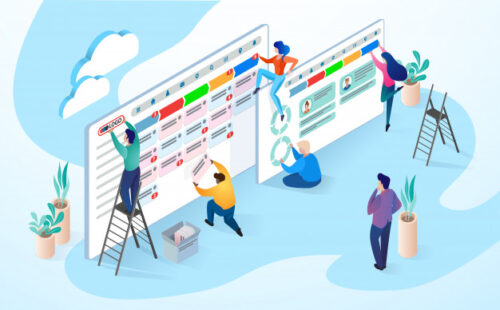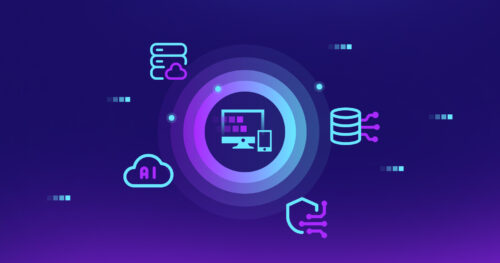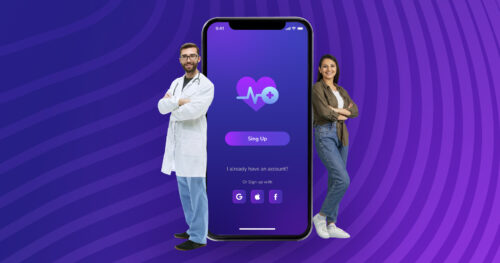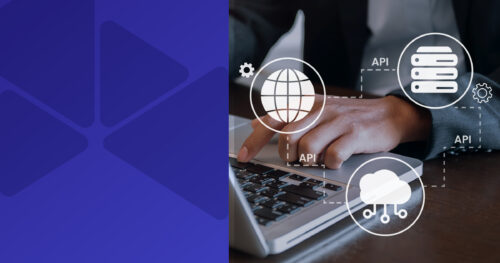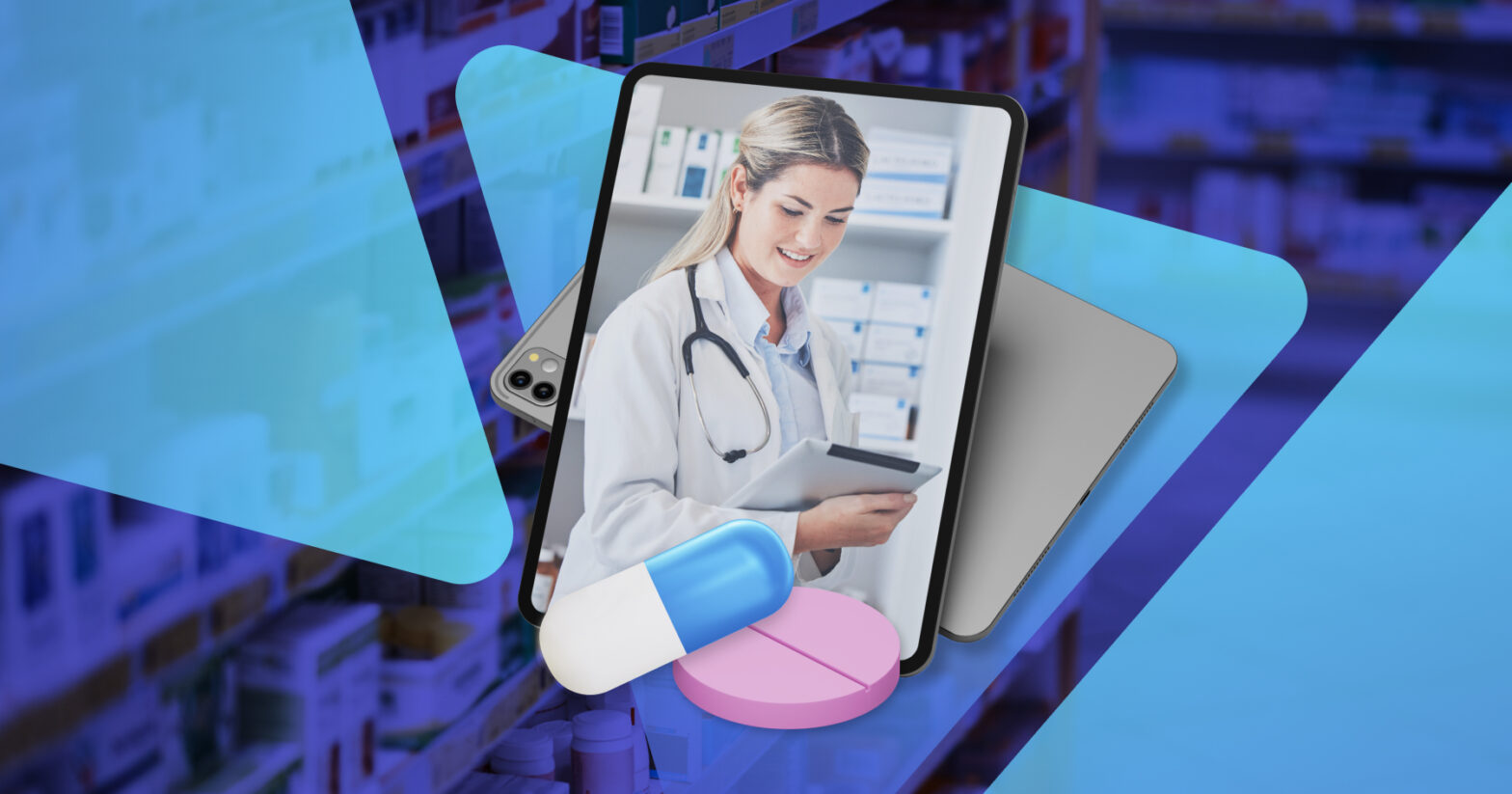Pharmacy is a vast field with significant potential for technological advancements and investments. Statista predicts revenue in the pharmacies market to reach US$1.45 trillion in 2024. Technologies are transforming how pharmacies operate, deliver care, and engage with patients. DigitalMara has explored the trends and software technologies that are enhancing pharmacy practices today. Understanding these basic tools is crucial in carrying on custom software development for the pharmacy field.
Technologies are affecting every facet of pharmaceutical activity, from R&D and production to prescriptions, sales, and medication intake. For convenience, we might categorize software and technologies for pharmacy into two types:
- Internal systems used by pharmacists and managers to perform their daily tasks and organize pharmacy operations.
- Customer and patient-facing technologies used to organize and control personal medication and healthcare from the customer’s perspective.
Internal pharmacy systems
Automated dispensing systems
Automated dispensing systems (ADS) serve various functions, including storage, dispensing, and tracking of medications. These systems increase efficiency and accuracy and minimize medication errors. The system has both hardware and software parts. The latter includes a user interface for pharmacists, modules for drug loading and inventory management, integration of barcode scanning, and real-time documentation functions.
Pharmacy management systems
A pharmacy management system (PMS) is a core software system that streamlines and automates a wide range of pharmacy-related tasks. The system allows for storing and managing patient profiles, including medical history; recording and managing prescriptions; generating and storing electronic prescriptions; tracking and managing the pharmacy’s inventory of medications and other products, monitoring expiration dates and removing expired items from stock; processing transactions and generating invoices and receipts; and generating reports on sales, inventory, and prescription history.
Electronic Health Records
An Electronic Health Records (EHR) system stores and manages patients’ information, including personal details, medical history, allergies, and current medications. Integration between EHR and PMS systems is essential, as this ensures seamless communication among healthcare providers, prescribers, and pharmacists, provides a smooth workflow, and reduces medical errors. EHR systems allow prescriptions to be processed electronically, reducing dependence on paper prescriptions. Pharmacists can access a patient’s prescription history, which helps identify potential drug interactions and ensures accurate dosing.
Technologies
The three systems above perform different tasks but have common technology filling, which means databases with vast amounts of data, reporting, integrations, and document management. These technologies also solve issues with accuracy, automation, and security.
Cloud technologies
The pharmaceutical industry today largely relies on legacy software for its operational activities. That means they lack the speed, agility, accuracy, and transparency of newer cloud-based technologies. During peak times, cloud-based solutions are far more resistant to high loads. They can be scaled up to handle increased demand without compromising performance. Better interoperability enables seamless integrations with other systems, medical devices, applications and various data sources. Pharmacies can exchange information with healthcare providers and medical activities to improve coordination and patient care.
Cloud technologies play a pivotal role in automating pharmacy software systems. Everyday tasks may be performed faster and more efficiently. For example, real-time inventory tracking, verification, and medication ordering in ADS. Order processing, medication dispensing, and clinical interventions in PMS. Centralizing patient health information, facilitating documentation, clinical decision support, and care coordination in EHR. Automation also reduces manual errors and allows pharmacies to focus more on patient care.
Databases and analytics
Pharmacies need to have easy access to patient records, medication information, inventory information and other essential info. Reliable and secure storage of large data volumes and advanced data management ensure data quality, integrity, availability and exchange. It’s important to consider that information is presented in both structured and unstructured forms, including text, figures and images (scans). The system should be able to handle it all properly.
Analytics is important for pharmacy operations to identify patterns in medication dispensing, manage inventory, forecast demand, and evaluate workflow efficiency. Pharmacists can also analyze patient characteristics and medication history to provide personalized recommendations on treatment. Companies in the pharmaceutical domain need to follow structured and safe approaches to collecting and analyzing data. Errors and miscalculations can lead to harmful consequences for health and medication.
Artificial Intelligence
Artificial Intelligence (AI) holds great potential in pharmacy, covering various aspects of medication management, patient care, and operational efficiency. Technology is important for medication decision support. AI algorithms can analyze patient data, medication histories, and clinical guidelines, and recommend best-fit medication, dosing and medication regimens. Analyzing medications databases, it can identify potential drug-drug interactions and raise alerts about potential risks for patients.
Pharmacists can benefit from automation of repetitive tasks, predictive analytics for inventory management, and quality control. AI algorithms can analyze historical data, prescription volumes, and external factors to forecast medication demand, optimize inventory levels, and reduce stockouts and wastage. Through image recognition systems, AI helps to identify medications based on images of pills or packaging and detect counterfeit or substandard products. It is easier for pharmacists to verify prescriptions and ensure accuracy in dispensing, patient safety and medication quality.
Security
Security is a critical aspect of pharmacy operations. Pharmacy software solutions require robust security measures to protect sensitive healthcare data from unauthorized access, breaches, and cyber threats. These measures include data encryption at rest and in transit, access control based on user roles and permissions, multi-factor authentication, pharmacy data backup and data recovery procedures, and regular security audits and compliance certifications.
Cloud-based solutions technologies bring several security benefits for pharmacies, including enhanced data protection, scalability, and flexibility. Thus, cloud service providers typically offer robust encryption mechanisms and access control. They adhere to industry-specific regulatory requirements and certifications; however, you always need to check which of those you need. Cloud technologies also allow for scheduling regular backups of critical data and recovering quickly from data loss or other incidents.
In addition, AI and ML, by analyzing pharmacy data, can identify abnormal patterns, behaviors and trends that indicate security threats or malicious activities, ensuring early detection of security incidents and a quick response to them. Intelligent algorithms can predict future security threats and vulnerabilities based on historical data, enabling proactive security measures and risk-mitigation strategies to prevent potential security breaches.
Customers and patients
Medication tracking software
Medication tracking software involves mobile apps that help patients manage and keep track of their medication schedules. They can encompass many features, such as custom reminders for each medication, including dosage and frequency, history of medication intake, health metrics such as blood pressure and blood sugar, and reactions to medications. The app sends push notifications and/or alerts to take medication on time, to refill prescriptions and consult with a healthcare professional.
The app benefits from the addition of technologies such as AI, chatbots, voice recognition, bar code scanning and integration with wearable devices. These elements can improve the user experience and expand the app’s potential. Barcode scanning reduces the risk of manual entry errors when adding medications to the app. Users also can gain access to comprehensive information about their medication such as instructions, potential side effects, and other relevant details. Chatbots can provide 24/7 support. They can interview users, track indicators, send reminders, give useful information, provide recommendations and create emergency signals, analyzing user’s data.
Voice recognition allows users to input medication information verbally and receive voice-based reminders. This simplifies the workflow, especially for elderly people and users with disabilities. When connected with wearable devices, the app can gather continuous health data such as physical activity, sleep patterns, and heart rate, and provide a more holistic view of the user’s well-being. Which is very important when taking medications.
AI algorithms can analyze real-time health data, including medication intake regimes, user behavior, medication history and other indicators. This empowers the app to provide personalized medication reminders and recommendations for lifestyle changes, additional medications and visits to the doctor; predict potential health risks; recommend dose adjustments for medications with variable dosages, and more.
Wearable devices
Wearable devices contribute to pharmacy technology as a part of patient care and medication management. Such devices can be particularly beneficial for individuals with chronic conditions and complex medication regimens. Devices can send reminders and emergency alerts, track and monitor medication intake, and monitor vital signs and health metrics, such as heart rate, blood pressure, and activities. The data from wearables can be used to detect potential issues and side effects from medication intake and to adjust treatment plans. In the global sense, wearables are useful in pharmaceutical research, collecting data in real-time during clinical trials. Researchers get additional insights on the studied medication’s effects.
E-pharma
Now customers don’t need to visit a physical pharmacy. They can use online platforms and mobile apps to request prescription refills, pay for their orders, check order status, and receive notifications when their medications are ready for pickup and order door-to-door delivery. Statista has estimated the value of the global online pharmacy sector to be $32 billion as of the end of 2023. And this figure will only grow in 2024.
E-pharma operates the same way as any e-commerce platform. However, there are some differences. For example, digital pharmacies must adhere to strict regulatory standards governing the sale and distribution of pharmaceutical products. Prescription verification and validation of customer information are obligatory for safety and mitigating the risk of misuse.
Chatbots play a significant role in online pharma, providing an automated, interactive, and personalized shopping experience. They provide detailed information about medicines, give preliminary advice on common health concerns, and assist with the full purchasing flow. Moreover, bots can send reminders to individuals to refill their prescriptions and send alerts when medical attention is needed. Just as for medical apps, data for chatbots in e-pharma needs to be collected in cooperation with healthcare professionals to avoid harmful mistakes.
AI also contributes to improving operational efficiency and the customer experience. On the seller’s side it can automate and ensure accuracy of prescription verifications, help optimize stock levels and ensure the availability of essential medications, streamline the order processing workflow, and detect fraudulent activities. Meanwhile, customers get more personalized medication recommendations, better support, and virtual consulting on potential health issues.
Regulatory compliance for pharmacy software
Pharmacy software, like other healthcare-related applications, must adhere to regulatory standards to uphold patient safety, data security, and legal concerns. Below are key regulatory benchmarks that pharmacy software solutions must follow:
- HIPAA (Health Insurance Portability and Accountability Act)
HIPAA establishes standards for safeguarding patients’ sensitive health information, referred to as protected health information (PHI). Pharmacy software should align with HIPAA regulations to ensure the confidentiality, integrity, and availability of patient data.
- FDA regulations (Food and Drug Administration)
Pharmacy software incorporating features related to medications should conform to FDA regulations and guidelines. For instance, software involved in medication dispensing, tracking, or documentation should adhere to the FDA’s requirements for electronic records and electronic signatures.
- DEA regulations (Drug Enforcement Administration)
If pharmacy software is involved in the handling or dispensing of controlled substances, it must comply with DEA regulations for electronic prescribing of controlled substances (EPCS) and other relevant stipulations.
- GDPR (General Data Protection Regulation)
While GDPR primarily pertains to organizations within the European Union, it may impact pharmacy software vendors if they handle personal data of individuals residing in the EU. Compliance with GDPR ensures the protection of personal data and privacy rights.
- Standards for interoperability
Pharmacy software should conform to industry standards for interoperability, such as Health Level Seven (HL7) and Fast Healthcare Interoperability Resources (FHIR). This ensures secure data exchange between various healthcare systems, fostering seamless integration.
Final words
The future of the pharmacy industry is intricately intertwined with digital innovation. Technological advancements present both opportunities and challenges. Cloud-based solutions have come to replace legacy software systems, opening the gate to automation and more accurate and efficient workflows. AI-based components, chatbots, advanced data analytics, wearable devices, voice recognition, barcode scanning, and other technologies have great potential to improve all types of pharmaceutical activities.
DigitalMara can be your reliable partner in custom software development for pharmacy.
We can build software systems from scratch both for web and mobile, add new features to your existing system, and modernize your legacy software. Choose our custom software development or IT team augmentation services to implement your project.






